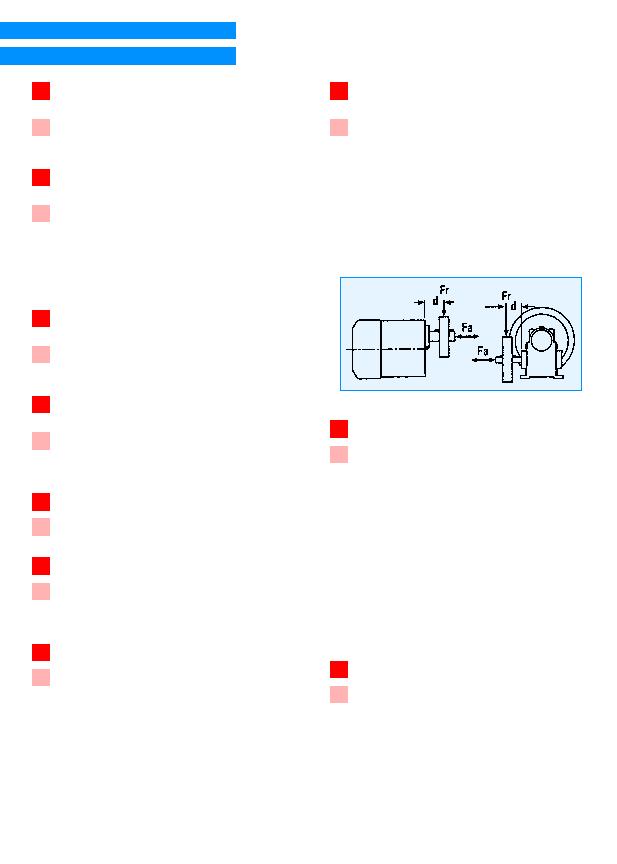
Some of your questions
answered!
Which motors/gearmotors are electrically
reversible?
All motors and gearmotors shown in this catalogue are reversible.
(except shaded pole). Some require a full stop before reversing.
Can continuous duty motors/gearmotors be used
intermittently?
All rated torques shown in this catalogue are for continuous
operation. Continuous duty products can be used intermittently.
Operation at loads higher than nameplate ratings is possible for short
periods as long as there are rest periods for cooling. Loads must not
exceed the mechanical rating for the gears (see page 5) without
consulting our sales engineers. The temperature of the motor should
be monitored during testing to make sure it is not overheating.
Can single speed motors and gearmotors ever be
operated as variable speed?
Three phase and some Permanent Split Capacitor designs may be
operated as variable speed with a frequency inverter. Commutator
motors can be operated as variable speed using a thyristor controller.
Is an adjustable speed system ever appropriate
for a single speed application?
Adjustable speed systems are sometimes appropriate for single
speed applications. If the desired speed is not known or not offered in
a single speed product, an adjustable speed system may be set to
the desired speed.
What is IP 54?
The IP number is an international system for rating enclosures.
An IP 54 is for protection against dust and splashing liquids.
What is meant by the term self locking?
Self locking refers to the tendency of some gearing to resist
movement when the gearmotor is at rest and the load is attempting to
move. An example is a load on a conveyer belt trying to drive the
system backwards.
Which gearheads are self locking?
Parallel shaft gearheads and right angle gearheads with low ratios
are generally not considered to be "Self locking". Right angle
gearheads with ratios greater than 25:1 are often considered to be
"Self locking". They will resist movement up to their torque rating. As
the gearing nears the end of its useful life or if it is subjected to
overload conditions, it may wear to the point where it is no longer
"Self locking". Self locking gearing is not a recommended method for
preventing movement in applications where this movement may
cause injury or damage. An external brake is recommended for those
applications. (see pages 6, 45 and 72)
A
Q
A
Q
A
Q
A
Q
A
Q
A
Q
A
Q
Can more than one motor be operated from a
single control?
Operation of more than one motor from a single control is not
normally recommended. However, when cost is a primary concern, a
multiple motor/single control system with either permanent magnet
motors and control, or 3 phase motors and control may be
successfully implemented. More than one permanent magnet motor
may be operated with a single permanent magnet control as long as
the sum of the motor currents does not exceed the rated output
current of the controller. Comprehensive testing is recommended
because this type of system may produce fluctuation or drifting speed
output. More than one 3 phase motor may be operated with a single
3 phase control. Motor speeds should not fluctuate as long as the
motors are not overloaded and the sum of the motor currents does
not exceed the rated output current of the control.
What is radial load?
Radial load is a force pushing or pulling the side of the output shaft. It
is shown as Fr above. Exceeding the allowable radial load for a
motor or gearmotor will cause premature wear of output shaft
bearings and gearing and could cause the shaft to break.
Fr may be the result of a weight on the shaft, belt tension or torque
transmitted through a belt, chain, gear, or certain flexible couplings. A
permissible radial load, Fr, is shown for each motor and gearmotor. In
calculating these values, the following assumptions were made:
1) The radial load is in the worst case direction, i.e. pushing or
pulling the shaft sideways.
2) The motor or gearmotor is delivering rated torque.
3) The radial load was applied at distance "d" from the hub or
mounting surface. Higher radial loads may be applied closer in on
the shaft. Lower radial loads are permitted further out on the
shaft.
Flexible couplings are often used to avoid radial load. Most flexible
couplings are designed so that they do not transmit radial load,
however this should be verified by the coupling manufacturer.
What is axial load?
Axial load is a force on the output shaft into or out of the motor or
gearmotor. It is shown as Fa in the diagram above. Exceeding the
allowable axial load for a motor or gearmotor will cause premature
wear of output shaft bearings and gearing.
A
Q
A
Q
A
Q
Radial and Axial load parameters
4

